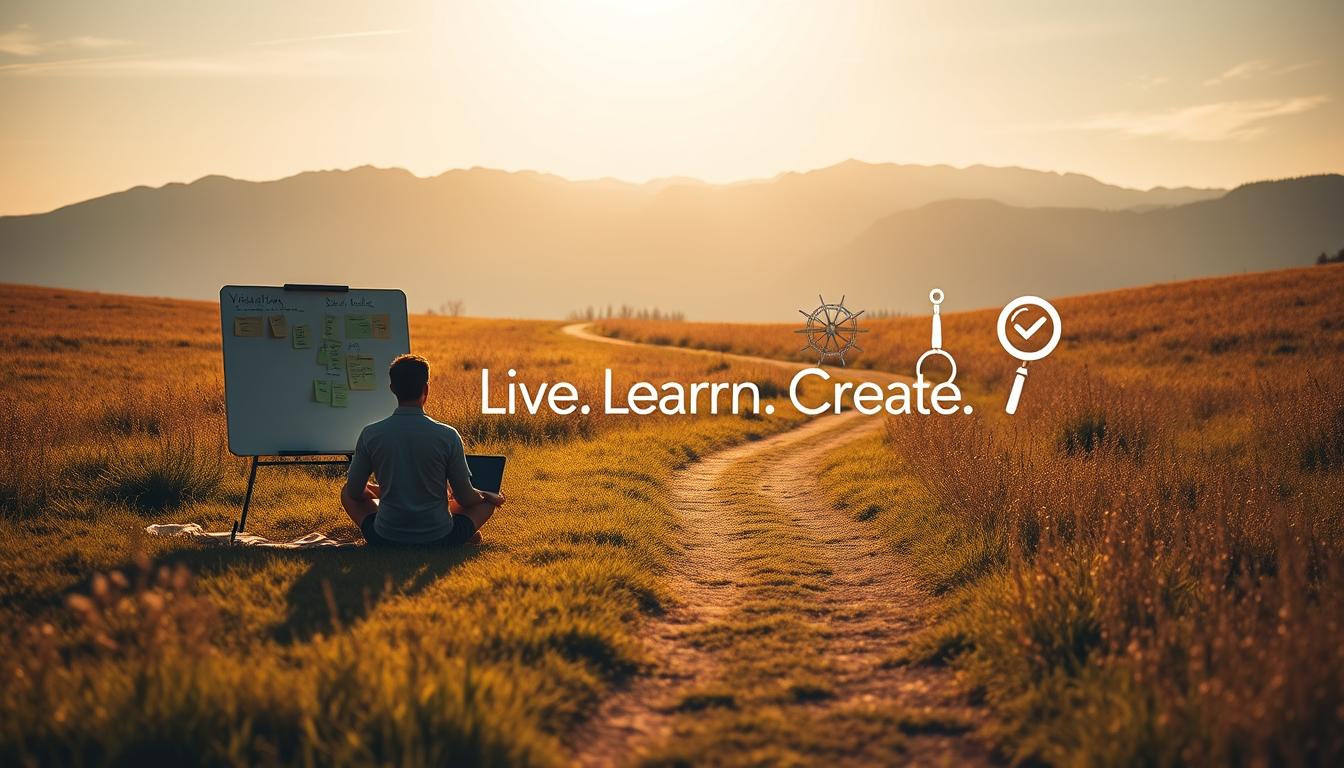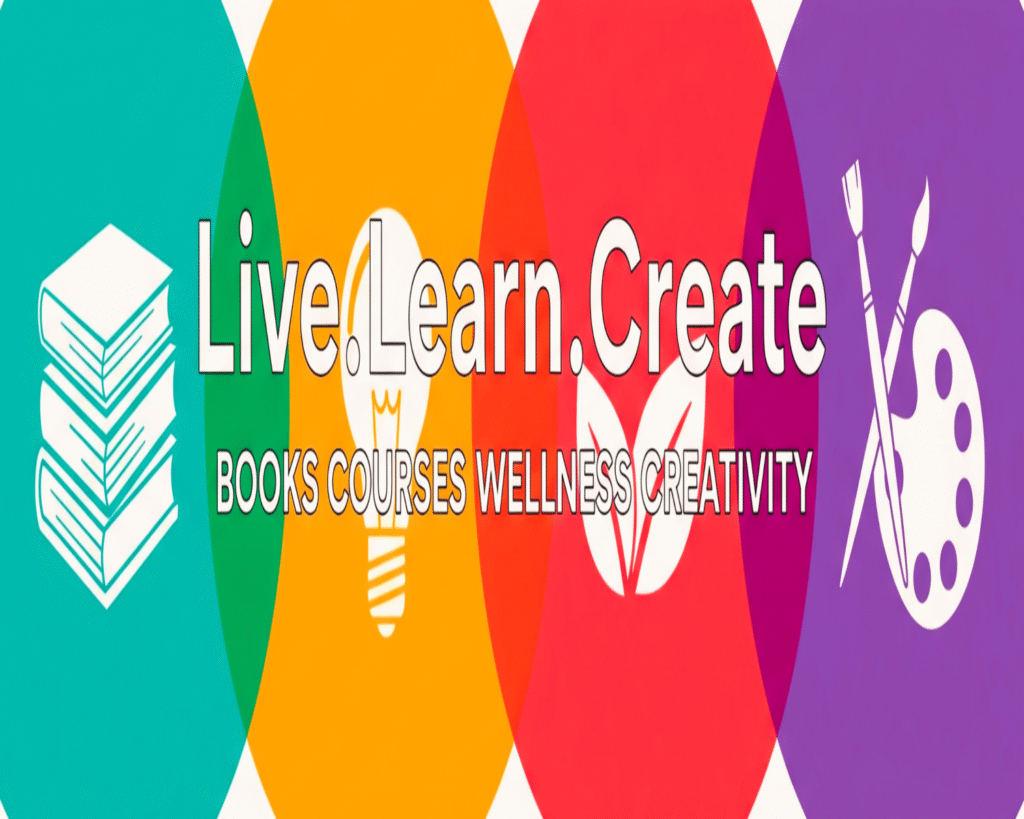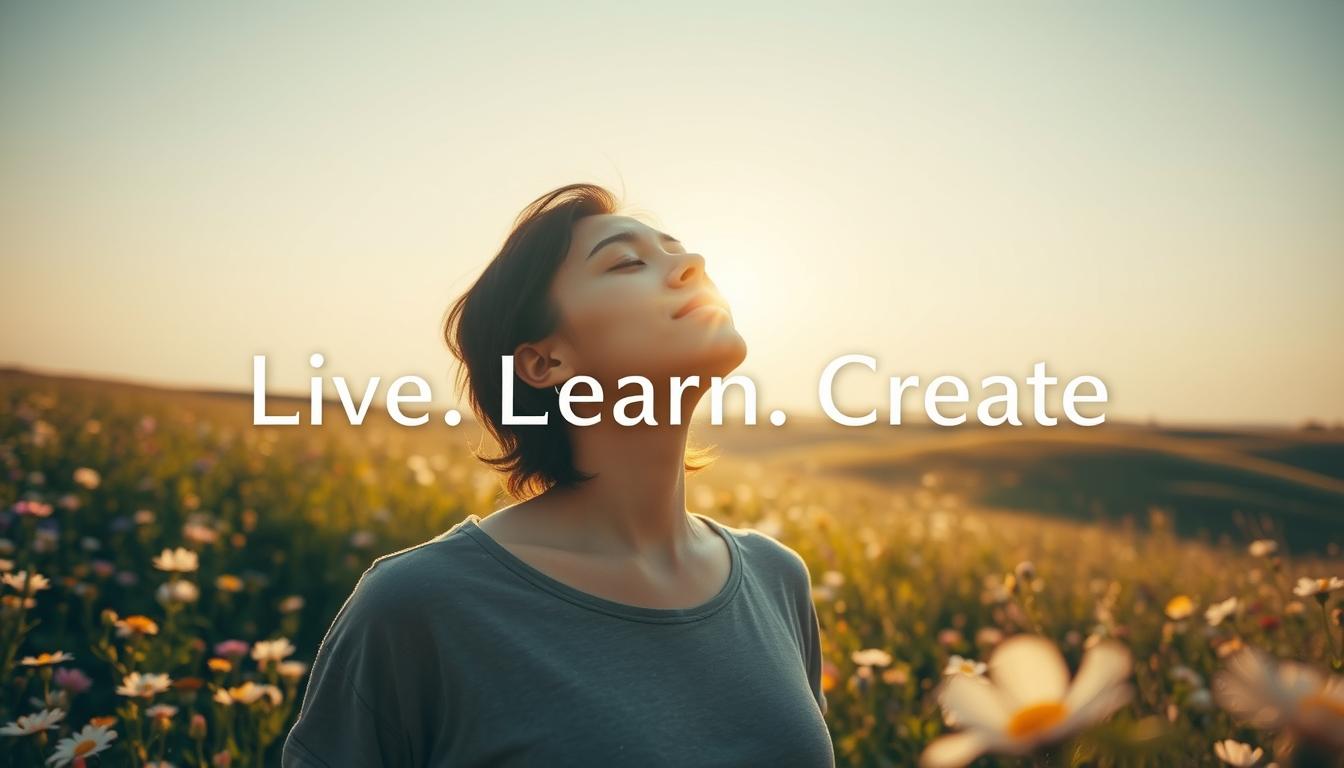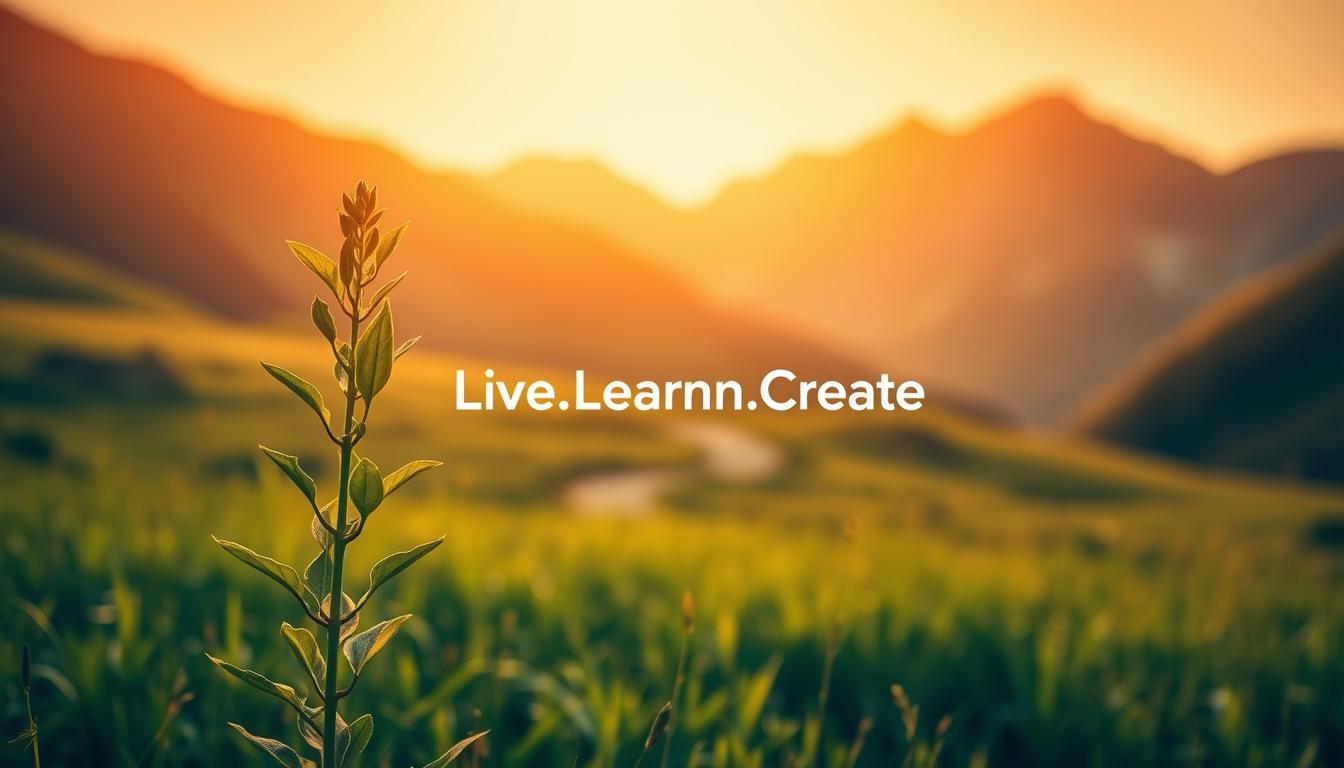“Action is the foundational key to all success.” – Pablo Picasso’s words remind us that progress fuels purpose. We’ve all felt that dip in energy—days when even small tasks feel heavy. But here’s what I’ve learned: Your drive isn’t broken. It just needs nurturing.
Think of goals as compasses, not finish lines. What lights your fire today might shift tomorrow—and that’s okay. Sustainable growth happens when daily choices mirror what truly matters to you. That’s where real momentum begins.
Let’s explore how your surroundings and routines shape your progress. Ever noticed how a cluttered space drains energy? Or how supportive friends make challenges feel lighter? We’ll uncover ways to design environments that pull you forward.
This isn’t about rigid systems. It’s about finding what clicks with your rhythm. Maybe visual trackers spark joy, or perhaps quiet reflection grounds you. Together, we’ll build tools that fit like your favorite pair of shoes—comfortable, reliable, and uniquely yours.
Key Takeaways
- Inner drive grows through intentional practice, not innate talent
- Meaningful progress stems from aligning actions with core values
- Your physical and social environments significantly influence follow-through
- Personalized systems outperform generic productivity hacks
- Small, consistent steps create lasting change more effectively than grand gestures
Understanding the Essence of Motivation
What keeps us moving forward when willpower fades? I’ve discovered it’s not just about effort—it’s about tapping into the invisible forces that shape our daily choices. Let’s unpack how our deepest needs fuel progress.
Key Psychological Drivers
Three core elements power our sense of direction: autonomy, competence, and connection. Autonomy isn’t about rebellion—it’s that quiet confidence when your choices align with your values. Competence grows when you master small wins, like finally nailing that recipe after five attempts. Connection? That’s the spark when someone says, “I see what you’re trying to do—let’s figure this out together.”
Research reveals something fascinating: Activities driven by personal joy light up different brain areas than those done for external rewards. Ever get lost in a hobby for hours? That’s intrinsic energy at work—your mind’s way of saying, “This matters.”
How Drive Shapes Outcomes
Here’s what surprised me most: People who nurture these psychological needs show 21% higher productivity. Why? Because purpose transforms routine tasks into stepping stones. A teacher emphasizing why algebra matters doesn’t just share equations—they’re fueling students’ sense of possibility.
Victor Vroom’s research backs this up. When we see how our work contributes to something bigger, even filing reports feels less like a chore and more like building a legacy. That shift in perspective doesn’t just enhance performance—it rewires how we approach challenges.
Effective Motivation Strategies for Achieving Goals
Ever feel like your ambitions outpace your energy? The bridge between dreams and reality lies in practical methods that turn intention into action. Let’s explore tools that make progress feel less like climbing Everest and more like walking a scenic trail.
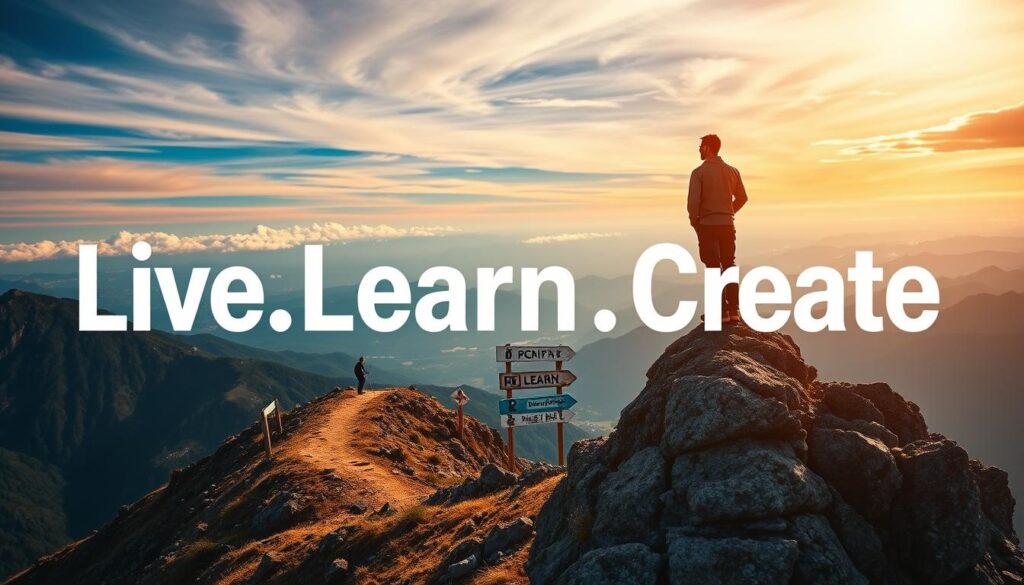
Actionable Listicle of Motivational Techniques
Start by slicing big objectives into bite-sized victories. Completing a 5-minute daily writing habit builds momentum faster than chasing “write a novel” in one swoop. Celebrate finishing week one with a favorite coffee blend—small wins deserve recognition.
Turn mundane tasks into playful challenges. Track reading goals with a colorful sticker chart, or compete with a friend to hit 10,000 steps first. Visual progress bars in apps like Habitica prove satisfying—watching that bar fill sparks joy.
Schedule “exploration hours” weekly. These creative breaks let you prototype ideas without pressure. A graphic designer might experiment with new software, while a student could map out passion project concepts. Fresh perspectives often reveal hidden opportunities.
- Design workspaces that whisper “You’ve got this”—post vision boards near your desk
- Pair 25-minute focused sprints with 5-minute dance breaks
- Share weekly wins with an accountability buddy who asks “What’s working?”
Remember—the best techniques feel like playing rather than pushing. If a system drains your energy, swap it for one that makes effort feel like curiosity in motion.
Boosting Professional and Workplace Motivation
What transforms a job into a calling? It’s the alchemy of feeling valued, challenged, and supported. Modern workplaces thrive when they nurture both growth and humanity—where spreadsheets meet soul.
Recognition That Resonates
True acknowledgment isn’t just about plaques or bonuses. It’s when your manager says, “Your approach to client meetings shifted our team’s results.” LinkedIn data shows 94% of professionals stay longer when companies invest in their career paths. Mentorship programs and skill-building workshops create tangible opportunities—like a barista mastering latte art to eventually manage a café.
Playful Progress Tracking
Sales teams using point systems for closed deals see 34% faster goal completion. Designers competing in weekly creative challenges report higher performance. Gamification works because it taps into our love for visible milestones—like watching a progress bar hit 100%.
| Traditional Approach | Modern Solution | Impact |
|---|---|---|
| Annual reviews | Real-time feedback apps | 41% faster skill growth |
| Fixed schedules | Flexible remote options | 27% lower burnout rates |
| Generic training | Personalized learning paths | 63% higher engagement |
Well-being as Foundation
Companies offering mental health days see 22% fewer sick days used. A environment with ergonomic chairs and quiet zones isn’t pampering—it’s respecting the human behind the work. When leadership models boundaries (like actually taking lunch breaks), teams mirror those healthy habits naturally.
Your career journey should feel like climbing with safety ropes, not free soloing. When organizations blend challenge with care, they create spaces where people don’t just work—they flourish.
Inspiring Student Motivation and Academic Success
What transforms classrooms into spaces where curiosity takes flight? It begins with trust—the kind that turns lessons into dialogues and assignments into discoveries. When education honors both knowledge and humanity, academic growth becomes inevitable.

Building Strong Teacher-Student Relationships
I’ve seen magic happen when educators ask, “What matters to you?” instead of just “What’s the answer?” Students feel valued when teachers remember their soccer tournaments or favorite books. These connections make tough assignments feel like teamwork rather than tests.
A study of 12,000 U.S. classrooms revealed something powerful: Learners with supportive mentors attempt harder tasks 37% more often. It’s not about being friends—it’s about showing genuine interest in how students develop their unique strengths.
Autonomy and Task Engagement
Choice changes everything. Letting students pick between essay topics or project formats sparks ownership. One middle schooler told me, “When Mrs. Lee let us design our science fair experiments, I stayed up late researching—because it felt like mine.”
Teachers who give students meaningful options see 42% higher completion rates. This isn’t lowering standards—it’s recognizing that different paths lead to the same destination. A math teacher might offer word problems about budgeting concert tickets or sports statistics.
Classrooms thrive when they blend structure with flexibility. Clear deadlines paired with creative freedom help students balance responsibility with self-expression. That balance nurtures the sense belonging every learner deserves.
Creating a Supportive and Inclusive Environment
True inclusion begins when we stop seeing differences as obstacles and start viewing them as building blocks. I’ve watched classrooms transform when educators ask, “What wisdom can we create together?” rather than “Who’s getting it right?” This shift turns spaces into living ecosystems where every voice fuels collective growth.
Fostering a Sense of Belonging and Ownership
Shared purpose starts with simple acts. A college professor I know begins each term by having students co-create classroom agreements. One rule they often choose: “Listen like you might learn something unexpected.” This practice helps students see themselves as architects of their environment, not just passengers.
Research shows that when peers collaborate on group norms, participation rates jump 58%. Why? Because ownership dissolves the us vs. them mentality. A 4th-grade teacher shared how letting students design project rubrics reduced anxiety: “They started challenging themselves more than I ever could.”
| Traditional Approach | Inclusive Practice | Impact |
|---|---|---|
| Top-down rules | Co-created agreements | 41% higher engagement |
| Assigned roles | Skill-based task selection | 67% better outcomes |
| Generic feedback | Strength-focused coaching | 3x more risk-taking |
Barriers crumble when we actively seek diverse perspectives. A tech company increased innovation by 22% after implementing “perspective swaps”—team members lead meetings using others’ communication styles. This isn’t about perfection; it’s about showing up authentically while making space for relationships to deepen naturally.
What I’ve learned: Sense belonging grows when we balance structure with spontaneity. A middle school’s “open mic Fridays” let students share poems, jokes, or science facts. Those moments didn’t just build connections—they revealed hidden talents that shaped future lesson plans.
Implementing Feedback Systems to Enhance Motivation
The art of growth lives in the spaces between effort and insight. I’ve seen firsthand how well-crafted feedback systems turn static goals into living journeys. When we frame input as collaborative dialogue rather than evaluation, it becomes fuel for curiosity.

Regular Feedback and Performance Metrics
Effective guidance feels like a compass, not a report card. A math teacher I admire uses color-coded notes: green for “This approach works because…” and blue for “Let’s explore another angle when…”. This method reduced test anxiety by 38% in her class while boosting performance.
Timing transforms feedback from afterthought to accelerator. Weekly 5-minute check-ins help learners adjust before frustration sets in. One student shared: “Knowing I’ll get tips every Friday makes me try harder all week—like I’m building something visible.”
Celebrating Achievements Effectively
Recognition shines brightest when it’s specific and sincere. Instead of generic praise, highlight the progress behind the win: “Your detailed research here shows how you’ve mastered sourcing credible data—this skill will serve all your future projects.”
| Traditional Feedback | Growth-Centered Approach | Result |
|---|---|---|
| Letter grades | Skill-specific rubrics | 42% more revision attempts |
| Year-end reviews | Biweekly micro-feedback | 3x faster goal completion |
| General praise | Strength-focused narratives | 67% higher confidence |
Celebrations gain power when tied to personal goals. A student aiming to improve essay structure might frame their first coherent outline—even with errors—as a milestone. This builds the “I can grow” mindset that drives lasting success.
Sustaining Long-Term Motivation with Daily Practices
Imagine tending a garden—not with frantic bursts of watering, but with steady care. Lasting progress thrives when we root our goals in routines that bend with life’s rhythms. Let’s explore how small, intentional choices build resilience against burnout.
Building Productive Habits
Consistency beats intensity every time. A student preparing for exams might spend 25 focused minutes daily on tough subjects rather than marathon cramming. This approach reduces anxiety while strengthening retention. Pair challenging tasks with rewards—like a walk after completing math problems—to create positive associations.
Goal Setting and Self-Efficacy
Effective targets balance challenge with belief. Break complex projects into “I can do this” steps: researching three sources before writing a paper’s introduction. Celebrate mastering each layer—it fuels the effort needed for the next. Studies show learners who track micro-wins maintain 73% higher engagement over time.
Your daily practice might look like morning reflection or evening skill-building. What matters is designing rituals that honor your capacity while gently expanding it. When learning feels like curiosity rather than obligation, you’ll find energy flows more freely.
FAQ
How do psychological drivers influence goal achievement?
Core needs like autonomy, competence, and connection fuel our drive to act—aligning tasks with these needs creates natural momentum. Recognizing these internal triggers helps tailor approaches to individual aspirations.
What workplace practices boost engagement?
Regular recognition, clear growth paths, and wellness initiatives build loyalty. Gamifying tasks—like milestone rewards or team challenges—adds playful energy while fostering collaboration and innovation.
Why do students thrive with autonomy?
Letting learners choose project topics or problem-solving methods builds ownership. Paired with supportive mentorship, this freedom strengthens confidence and deepens investment in outcomes.
How does feedback sustain progress?
Specific, timely input helps refine efforts and celebrate small wins. Public acknowledgment—like shoutouts in meetings—reinforces positive behaviors while nurturing a culture of shared success.
Can daily habits prevent burnout?
Yes! Micro-routines like morning intention-setting or weekly reflection blocks create structure. Pairing these with achievable milestones builds self-trust, making long-term goals feel manageable.
What makes inclusive environments motivating?
When people feel their voice matters—through team decisions or peer-led initiatives—they contribute more passionately. Shared ownership transforms tasks into collective missions rather than obligations.
Transform your home into a more peaceful and mindful sanctuary. Creating a Zen-inspired home environment is a core part of the “Live.Learn.Create” theme, focusing on peace, mindfulness, and a clutter-free space. Here is a curated list of Zen home items.
The Zen Essentials
These items are the building blocks of a calm, intentional living space.
- Candles & Scents:
- Scented Candles: Look for calming, natural scents like sandalwood, lavender, white tea, or bergamot. Choose candles made with soy or beeswax for a clean burn.
- Essential Oil Diffusers: A minimalist, sleek diffuser made of bamboo, ceramic, or glass.
- Essential Oil Sets: Look for blends specifically for relaxation, focus, or sleep.
- Incense & Burners: Natural incense sticks (e.g., palo santo, sage) with a simple, elegant burner.
The Zen Decor
This is about incorporating natural elements and simple design.
- Natural Materials:
- Wood or Bamboo Trays: For organizing candles, stones, or other small items.
- Ceramic Vases: Simple, unglazed ceramic vases in neutral colors like white, beige, or gray.
- Minimalist Art: Simple line drawings, abstract prints, or nature-inspired artwork.
- Hand-Carved Stone Coasters: Or other small stone sculptures.
- Textiles:
- Linen or Cotton Throws: A soft, neutral-colored throw blanket to add warmth.
- Jute or Sisal Rugs: These add natural texture and grounding to a space.
- Meditation Cushions (Zafu) & Mats (Zabuton): These provide comfort for meditation and add a serene touch to a room.
The Zen Ambiance
These items help create a peaceful sensory experience.
- Lighting:
- Himalayan Salt Lamps: These provide a warm, soft glow.
- Japanese-style Paper Lanterns: For a soft, diffused light source.
- Dimmable Smart Bulbs: To easily control the warmth and brightness of your lighting.
- Sound:
- Tabletop Water Fountains: The gentle sound of running water is incredibly calming.
- Wind Chimes: Made from natural materials like bamboo or metal for a soft sound.
- Bluetooth Speakers: Small, aesthetically pleasing speakers for playing ambient or meditation music.
- Nature:
- Bonsai Trees or Air Plants: Low-maintenance indoor plants that bring life and a touch of nature indoors.
- Zen Gardens: A small, tabletop sand garden with a rake and stones for a meditative ritual.
- Decorative Rocks & Pebbles: For bowls or as a decorative element.
Best Sellers https://amzn.to/3Vet1tI
New Releases https://amzn.to/4mwLjTi
Amazon Movers & Shakers https://amzn.to/4fPsZlP
Mindfulness Coloring Books https://amzn.to/4fQ0wMx
Personal Growth Coloring Books https://amzn.to/4lJeRf0
Health & Wellness https://amzn.to/4oRt24C
Zen Home Decor https://amzn.to/3VeA3i6
Zen Garden Decor https://amzn.to/4mXjT8D
Zen Garden https://amzn.to/3HQTVVB
- Mindfulness & Meditation:
- Physical Wellness:
- Habit & Productivity Tools:
- Books:
- Best-selling personal development books (Mindset, The 7 Habits of Highly Effective People, The Subtle Art of Not Giving a F*ck)
- Books on a variety of skills (coding, photography, writing.)
- Educational Gadgets:
- Smart pens that digitize notes (e.g., Rocketbook)
- Portable scanners for digitizing documents
- Laptops, tablets, and accessories
Create (Creativity, Innovation, Projects)
These products cater to your creative side, whether you are a artists, writer, or DIY enthusiasts.
- Creative Supplies:
- Adult coloring books or “paint-by-sticker” books
- Craft kits (e.g., candle-making, pottery, embroidery)
- Digital Creation Tools:
- General Inspiration & Making:

